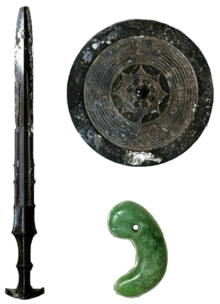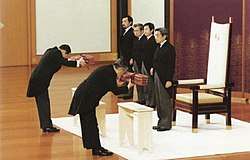Imperial Regalia of Japan
The Three Sacred Treasures (三種の神器, Sanshu no Jingi/Mikusa no Kamudakara) are the imperial regalia of Japan and consist of the sword Kusanagi no Tsurugi (草薙劍), the mirror Yata no Kagami (八咫鏡), and the jewel Yasakani no Magatama (八尺瓊勾玉). They represent the three primary virtues: valor (the sword), wisdom (the mirror), and benevolence (the jewel).[1]
| Part of the series on |
| Japanese mythology |
|---|
 |
|
| Texts and myths |
| Sacred objects |
| Mythical locations |


Due to the legendary status of these items, their locations are not confirmed, but it is commonly thought that the sword is located at the Atsuta Shrine in Nagoya, the jewel is located at the Three Palace Sanctuaries in Kōkyo (the Imperial Palace in Tokyo), and the mirror is located at the Ise Grand Shrine in Mie Prefecture.[2]
Tradition
Since 690, the presentation of these items to the Emperor by the priests at the shrine has been a central element of the enthronement ceremony. This ceremony is not public, and these items are by tradition seen only by the Emperor and certain priests. Because of this, no known photographs or drawings exist. Two of the three treasures (the jewel and the sword), as well as the Privy Seal and State Seal, were present at the abdication of Emperor Akihito on 30 April 2019.[3] Akihito's successor, Naruhito, formally took possession of them in a brief ceremony on 1 May 2019.[4] Prior to these events, they were last in public during the accession and enthronement of Akihito in 1989 and 1990. On all of these occasions, they remained shrouded from view in packages or boxes.
According to legend, these treasures were brought to earth by Ninigi-no-Mikoto, legendary ancestor of the Japanese imperial line, when his grandmother, the sun goddess Amaterasu, sent him to pacify Japan. These treasures were eventually said to be passed down to Emperor Jimmu, who was the first Emperor of Japan and was also Ninigi's great-grandson. Traditionally, they were a symbol of the emperor's divinity as a descendant of Amaterasu, confirming his legitimacy as paramount ruler of Japan. When Amaterasu hid in a cave from her brother Susanoo-no-Mikoto, thus plunging the world in darkness, the goddess Ame-no-Uzume-no-Mikoto hung the mirror and jewels outside the cave and lured her out of the cave, at which point she saw her own reflection and was startled enough that the gods could pull her out of the cave. Susanoo later presented the sword Kusanagi to Amaterasu as a token of apology; he had obtained it from the body of an eight-headed serpent, Yamata no Orochi.
At the conclusion of the Genpei War in 1185, the eight-year-old Emperor Antoku and the Regalia were under the control of the Taira clan. They were present when the Taira were defeated by the rival Minamoto clan at the Battle of Dan-no-ura, which was fought on boats in the shallow Kanmon Straits. The child emperor's grandmother threw herself, the boy, the sword, and the jewel into the sea to avoid capture. The mirror was recovered, but according to the main account of the battle, a Minamato soldier who tried to force open the box containing it was struck blind. The jewel was recovered shortly afterwards by divers, but the sword was lost.[5] There are a number of medieval texts relating to the loss of the sword, which variously contended that a replica was forged afterwards, or that the lost sword itself was a replica, or the sword was returned to land by supernatural forces.[6]
The possession by the Southern Dynasty of the Imperial Regalia during the Nanboku-chō period in the 14th century has led modern chroniclers to define it as the legitimate dynasty for purposes of regnal names and genealogy.
The importance of the Imperial Regalia to Japan is also evident from the declarations made by Emperor Hirohito to Kōichi Kido on 25 and 31 July 1945 at the end of World War II, when he ordered the Lord Keeper of the Privy Seal of Japan to protect them "at all costs".[7]
Cultural references
The phrase "Three Sacred Treasures" is retrospectively applied to durable goods of modern Japan. During a policy address in 2003, then-Prime Minister Junichiro Koizumi said that during the mid-1950s and mid-1960s, the "three sacred treasures" for durable goods were the washing machine, refrigerator, and the black and white television, and the automobile, air conditioner, and color television set from the mid-1960s to the mid-1970s.[8][9]
Alvin and Heidi Toffler's Powershift use them to symbolize the three kinds of power they distinguish: force (sword), wealth (jewel) and knowledge (mirror).[10]
In the fighting game The King of Fighters '97, the plot revolves around having one character representing each Sacred Treasure to defeat the embodiment of the Yamata no Orochi.
In the manga franchise One Piece, the three main attacks of Admiral Kizaru (real name Borsalino) share their names with the Three Sacred Treasures.
In Pretty Soldier Sailor Moon, a popular Japanese manga and anime franchise, the three talismans of the Outer Senshi are stylized as a mirror, sword, and jewel. When brought together, they manifest the Holy Grail.[11]
See also
References
- ミニ講話 宮司のいい話 (in Japanese).
- Sansom, George (1961). A History of Japan 1334–1615. Stanford University Press. p. 9. ISBN 0804705259.
- McCurry, Justin (30 April 2019). "Japan's emperor Akihito abdicates with message of love". The Guardian. ISSN 0261-3077. Retrieved 30 April 2019.
- McCurry, Justin (1 May 2019). "Japan welcomes new emperor Naruhito as Reiwa era begins". The Guardian. Retrieved 1 May 2019.
- Turnbull, Stephen (2006) Samurai: The World of the Warrior, Osprey Publishing, ISBN 978-1841769516 (pp. 33-38)
- Selinger, Vyjayanthi R. (2013) Authorizing the Shogunate: Ritual and Material Symbolism in the Literary Construction of Warrior Order, Brill Academic Publishers, ISBN 978-9004248106 (pp. 114-118)
- Kido Koichi nikii, Tokyo, Daigaku Shuppankai, 1966, pp.1120–21.
- "General Policy Speech by Prime Minister Junichiro Koizumi to the 156th Session of the Diet". Prime Minister of Japan and His Cabinet. 31 January 2003. Retrieved 5 September 2017.
(Structural Reform in Lifestyle) From the mid-1950s to the mid-1960s, washing machines, refrigerators, and black and white televisions were called the "three sacred treasures" that symbolized the new lifestyle; from the mid-1960s to the mid-1970s they were automobiles, air conditioners, and color televisions.
- https://edition.cnn.com/style/article/japan-enthronement-royal-regalia/index.html
- Powershift: Knowledge, Wealth and Violence at the Edge of the 21st Century (1990), Bantam Books, Alvin and Heidi Toffler, ISBN 0-553-29215-3.
- Takeuchi, Naoko (2012). Pretty Soldier Sailor Moon. Vol. 7 Act 32. Kodansha Comics. ISBN 978-1612620039.
